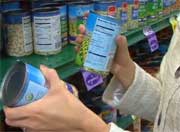- Skip Storing This Everyday Product in the Fridge Door
- Green Tea + B3 Pairing May Boost Brain Health
- Navigating Your Midlife Crisis: Embracing New Possibilities
- City Raccoons Showing Signs of Domestication
- Mapping the Exposome: Science Broadens Focus to Environmental Disease Triggers
- One Week Less on Social Media Linked to Better Mental Health
- Your Brain Changes in Stages as You Age, Study Finds
- Some Suicide Victims Show No Typical Warning Signs, Study Finds
- ByHeart Formula Faces Lawsuits After Babies Sickened With Botulism
- Switch to Vegan Diet Could Cut Your Greenhouse Gas Emissions in Half
Read Food Labels to Combat Childhood Obesity


One way to fight childhood obesity is to pay close attention to food labels when you go to the grocery store, a nutrition expert says.
The Nutrition Facts label reveals the number of calories and percentage of a day’s worth of nutrients in one serving of a food product.
When reading this label, be sure to check the serving size, which may be different from the amount your child actually eats, said Shirley Blakely, a registered dietitian with the U.S. Food and Drug Administration.
When assessing nutrient recommendations for one day, known as Percent Daily Value, you need to know that 5 percent or less is low, while 20 percent is high, Blakely said.
Look for foods that provide 20 percent or more of daily recommendations for protein, fiber and some essential vitamins and minerals per serving. And try to choose products that contain 5 percent or less of saturated fats and sodium per serving, she said.
Select products that contain no trans fats, which raise levels of bad LDL cholesterol and lower levels of good HDL cholesterol, Blakely added.
You also need to check the list of ingredients on all prepared and packaged foods. This label lists every ingredient used in a product, with the main ingredient first, the next most common ingredient second and so on in descending order.
For example, it’s a good sign if your children’s favorite cereal has some type of grain — such as oats or corn — listed first. But you don’t want them to eat cereals that list sugar — such as fructose, high fructose corn syrup or sucrose — first on the list of ingredients, Blakely said.
More information
The U.S. National Library of Medicine has more about nutrition.
Source: HealthDay
Copyright © 2025 HealthDay. All rights reserved.










